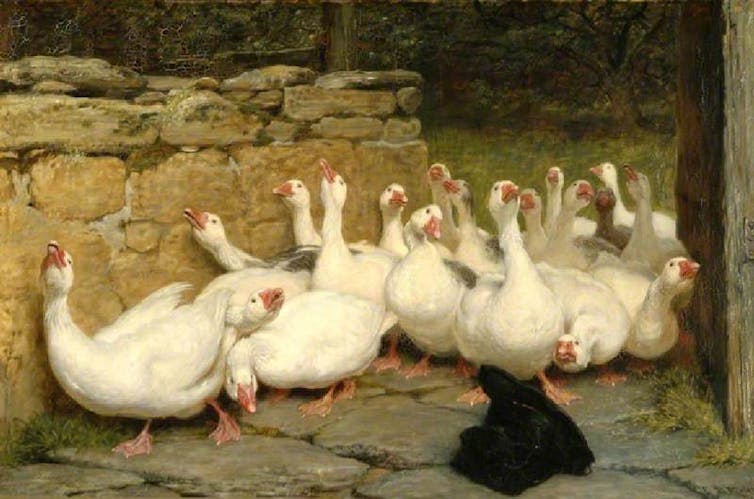To start (or to use up leftovers): Turkey soup
English writer Isabella Beeton’s soup essentially involved simmering the bones and leftover meat of your Christmas turkey into an existing stock to enrich it, before using a thickening agent to make it even richer.
Her reference to “Harvey’s Sauce” demonstrates how common it was to buy branded, mass-produced foodstuffs by this point in the 19th century. A thin, strong-tasting ketchup flavoured with anchovies, garlic, and cayenne, the punchy sauce was the brain-child of culinary expert Peter Harvey in the early 1800s. It became so popular that it was frequently referenced in Victorian literature. It made a lively addition to any soup or gravy.
National Portrait Gallery
Ingredients: two quarts of medium stock, the remains of a cold roast turkey, two oz. of rice-flour or arrowroot, salt and pepper to taste, one tablespoonful of Harvey’s Sauce or mushroom ketchup.
Method: Cut up the turkey in small pieces and p…lour or arrowroot to a batter with a little of the soup; add it with the seasoning and sauce, or ketchup. Give one boil, and serve.
The main course: Roast goose
This recipe, taken from a popular, London-based periodical that included items of fashion, literature, current events, recipes, and domestic advice, is typical of the 19th-century recipe form.
In contrast to Beeton’s organized recipe, most recipes came in one or more paragraphs. Victorians had to read the entire piece in order to understand what ingredients and equipment they required.
The recipe also relies on the reader knowing that a “quick” fire meant a fiercely burning fire, ascertaining when the bird was cooked, and making gravy without instruction. If you were capable of doing so, you could enjoy an alternative to the ever-popular turkey, alongside those in Scotland and the north of England.

Royal Holloway, University of London
In Scotland and the north of England, roast goose is a favourite piece de resistance for Christmas, and, in good sooth, when the bird is young, fat, and well-cooked, there are few viands to beat it. Take sage and wash it, pick it clean, chop it small, with pepper and salt role them with butter and put them into the belly. Never put onion in anything unless you are sure that everybody likes it. Take care that your goose be clean-picked and washed. Either singe or scald the bird. The best way is to scald a goose, and then you are sure it is clean and not so strong. Let your water be scalding hot, dip in your goose for a minute, and all the stumps of feathers will come off clean. When it is quite clean wash it in cold water, and dry it with a cloth; roast it, and baste it with butter, and when it is half-done through some flower [sic] over it, that it may have a fine brown. Three-quarters of an hour will do it with a quick fire, if it is not too large, otherwise it will require an hour. Always have good gravy in one tureen and apple sauce in another.
Pudding: Cottage Christmas pudding
English food writer Eliza Acton’s book Modern Cookery was highly popular over the 19th century. She introduced structure to her recipes before Beeton, though many claim the latter was the first to organize recipes in a way that’s more recognizable to modern readers.
What’s most intriguing about this festive recipe, however, is the inclusion of potatoes in the Christmas pudding. The reasons for this are best interpreted through the use of “cottage” in the recipe’s title, which indicates that this type of pudding might have been made in more rural or working-class areas.




